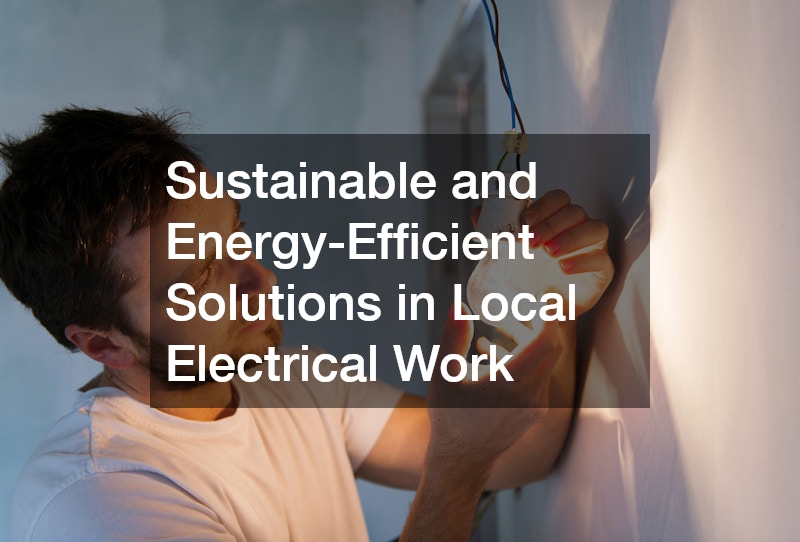In today’s environmentally conscious era, there’s a significant push towards sustainable and energy-efficient solutions in various sectors, including electrical work. This article explores some of the most asked questions about implementing these green solutions in local electrical work and their substantial benefits. As climate change and resource depletion become pressing concerns, local electrical practices must evolve toward sustainability, enhancing both ecological balance and economic efficiency.
What are the Best Practices for Implementing Sustainable Electrical Solutions?
Understanding the Principles of Sustainability in Electrical Work
The principles of sustainability in electrical work revolve around reducing energy consumption, minimizing waste, and promoting renewable energy sources. Local electricians can integrate these concepts into their projects by evaluating energy needs and opting for environmentally friendly materials. Implementing practices such as proper insulation and the use of energy-efficient appliances also contribute significantly to sustainable electrical solutions.
Beyond just product selection, sustainability in electrical work involves planning and designing systems that are adaptable and future-proof. Electricians are encouraged to adopt lifecycle thinking, considering not just immediate needs but long-term impact and disposability. Continuous education on sustainable technologies and practices ensures that professionals remain leaders in energy-efficient electrical work.
Key Sustainable Technologies for Local Electrical Installations
Sustainable technologies have revolutionized local electrical installations, introducing energy-efficient lighting options like LEDs that significantly reduce electricity use. Smart systems, such as programmable thermostats and sensors, optimize energy consumption by allowing users to control and automate usage. These innovations contribute not only to reduced energy bills but also to the longevity of electrical systems.
Renewable energy sources like solar panels have become pivotal in local electrical projects, offering a sustainable alternative to traditional energy supplies. By harnessing natural energy, properties can drastically cut their carbon emissions while achieving long-term savings. Moreover, integrating battery storage systems allows for the efficient use of generated power, maximizing the benefits of renewables.
Challenges and Solutions for Adopting Sustainable Practices
One of the primary challenges in adopting sustainable practices is the initial cost associated with new technologies, which can be prohibitive for some clients. To address this, local electricians can educate customers on the long-term financial benefits and available incentives. Grants, rebates, and tax credits can help offset initial expenses, making sustainability more accessible.
Another challenge is the rapid pace of technological advancements in energy efficiency, which can make it difficult for electricians to stay updated. Regular training and participation in professional workshops ensure adherence to the latest standards and the use of cutting-edge technologies. Networking with peers and industry groups also provides valuable insights into best practices and new innovations.
How Do Energy-Efficient Solutions Impact Cost and Performance?
Long-term Financial Benefits of Energy-Efficient Systems
Investing in energy-efficient systems can lead to significant cost savings over time due to reduced energy consumption and utility bills. Efficient systems often come with warranties that offer protection and reduce maintenance costs, further enhancing savings. A key fact is that the initial higher expense of sustainable installations is often recouped within a few years through cost reduction.
As energy-efficient systems reduce reliance on less sustainable power sources, clients benefit from greater price stability against fluctuating energy market prices. This financial predictability is highly valued by both residential and commercial clients. Additionally, property values can increase as energy efficiency and sustainability become increasingly desirable traits in real estate.
Performance Enhancements Through Energy Efficiency
Energy-efficient solutions are not only cost-effective but also deliver superior performance and reliability compared to traditional systems. These systems are designed to optimize energy use, which helps maintain optimal operating conditions and enhance performance longevity. Reduced waste and overheating issues contribute to fewer breakdowns and malfunctions.
Improved performance through energy efficiency also facilitates better environmental control within premises, leading to increased occupant comfort. For commercial spaces, this can translate to higher productivity and employee satisfaction. Energy-efficient systems often operate more quietly and smoothly, adding an additional layer of comfort and reliability.
Comparative Analysis of Traditional vs Energy-Efficient Solutions
Traditional electrical systems typically consume more energy and have higher operating costs, while energy-efficient counterparts are designed to minimize waste and optimize performance. The environmental impact is more pronounced with traditional systems due to higher emissions and energy consumption. In contrast, energy-efficient solutions drastically lower carbon footprints, contributing to environmental sustainability.
As sustainability continues to gain traction, local electrical work is poised to adapt with innovative, energy-efficient solutions that offer both economic and environmental benefits. By understanding and implementing these practices, electricians can contribute to a more sustainable future while delivering exceptional performance and cost savings to their clients.
.








